Tucked away on the third floor of McCardell Bicentennial Hall, Room 367 takes up a sliver of the giant science center. At 8 feet by 14 feet, it’s roughly the size of a storage closest—which is actually what the space was originally designed to be. For the last decade, however, it has housed one of Middlebury’s more curious experiments. And this past J-term, Cecelia “Cece” Wheeler ’19 and biology professor Tom Root stood, side-by-side, staring at its latest iteration.
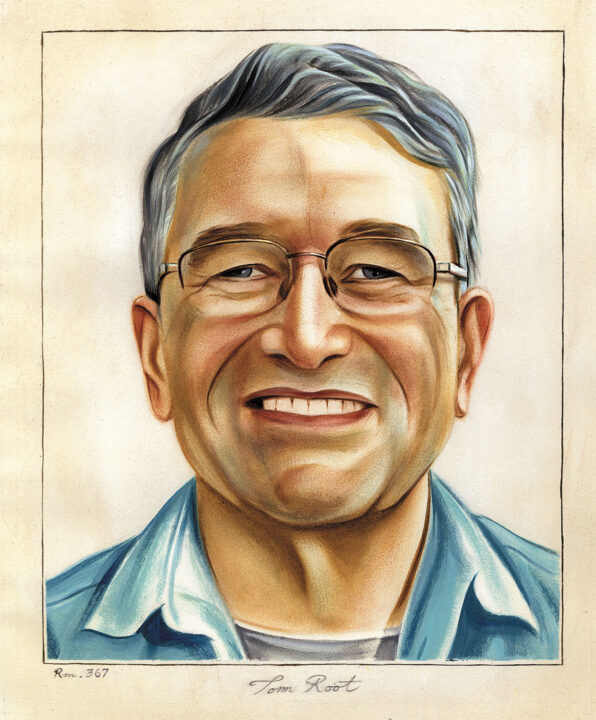
“Which one is this?” he asked.
“It’s Goose,” she replied. “He’s gotten really big.”
“Is he one of the better camouflagers?” Root inquired, partly in his role as her advisor and partly out of curiosity.
“He’s gotten pretty old recently,” she said. “But he used to be pretty good.”
Goose is not, in fact, a goose. He’s an octopus that, at that moment, had decided to turn dark green. Since the fall, Goose and the nine other octopuses in this makeshift lab had been the subjects of Wheeler’s thesis research. Her goal sounded relatively simple—she wanted to learn more about, and better quantify, how octopuses camouflage themselves. It’s an attribute that she says is pretty widely acknowledged in popular culture but surprisingly less explored by scientists. “Considering all the articles saying they’re the masters of camouflage, it’s amazing how few studies [there are],” said Wheeler, of the mere 19 previous articles she could find on the subject. “What I’ve been doing is trying to establish what visual cues octopuses use when they camouflage themselves.”
To do this, she put her octopuses against varying types of backgrounds and measured the animals’ camouflage response. For example, if she put them on a plain background, they tended to turn a more uniform color. But if the background was more disparate—say, made up of large chunks of white or black—the octopus would echo that with a more varied pattern. Wheeler applied a manual grading system to her data, but would like to eventually quantify those changes using computer imaging software. It’s something she says has been done before with other cephalopods, like cuttlefish, but never octopuses.
Wheeler’s study was among the most complex that have taken place in Middlebury’s octopus lab.
Results aside, the fact that Wheeler’s research was even possible is a testament to both the ingenuity of previous students and Root’s teaching style, which he has honed over his 39 years in the classroom—a run that comes to an end this May, when he retires.
Tom Root—my father—took the long road to Middlebury. Born in Detroit, he was the first in his family to attend college. His original plan was to be an engineer, but within the first week of class he decided that the drafting was too daunting (“I can’t draw a straight line”). So he took a turn toward animals that eventually led him to Laramie, Wyoming, to pursue a doctorate in zoology and a dissertation on scorpions. He spent many a night in the depths of the western deserts, searching for specimens. Armed with high boots, thick socks, and a black light, he’d wander for hours, collecting as many scorpions as possible—and hopefully avoiding their poisonous stingers, though not always. He remembers at least three painful mishaps, and one stop by U.S. Border Patrol agents, who wondered what he was doing in the desert in the middle of the night.
My dad arrived at Middlebury in 1979. It was the farthest east he had ever lived, and he settled in Ripton, which—with a population of perhaps 500—proved more remote even than Laramie. But in many ways, Middlebury was exactly the environment he was hoping for. Class sizes were small, the students were bright, and there was plenty of room for scientific exploration. He started off teaching animal physiology and vertebrate biology but soon developed his own course, focused on invertebrates. My dad then taught in the old science building (which stood on the site now occupied by Davis Family Library), and that’s where he met students like Colin Harrington ’83. “When you’re raw, you need someone to kick your ass, but in a way that’s encouraging,” said Harrington, who went on to do thesis work with my dad, and is now a doctor. “Your dad let me dive [in] headlong.”
Over the years, the cadre of alumni who took his courses grew to dozens, then hundreds, and now likely thousands. They tell stories of weird animals—including an infamous final where students have to identify the Latin names of random creatures—and field trips. “There was a group of us who sort of gravitated to him senior year. We went to the neuroscience convention in Cincinnati,” remembered Charles Hemenway ’81. “We piled in the van and drove straight through the night.”
As a kid, I went along on his invertebrate class trips to Maine. There were van rides—complete with Madonna’s “Like a Prayer” and the occasional hungover student—and lobster dinners, where my dad made everyone identify different parts of the animal before eating it. During the days, the students would comb the tide pools, setting quadrats and counting whatever was inside. At night, everyone would head back out with flashlights to find the starfish, larvae, and crabs that make the dark their haven. It was, in short, an adventure.
“I’ve spent a lot of time encouraging my research students especially, but also students in my classes, to do innovative things.” said my dad. “To try something that’s new and different.”
Carey Nichols ’08 took invertebrate biology with my dad his sophomore year. He remembers the trip to Maine, and my dad’s lectures about all the usual suspects: scorpions, flies, jellyfish, earthworms, snails, crabs, crayfish, barnacles, etc. But one lesson in particular stuck out: octopuses. “I remember Tom talking a lot about how smart they are,” said Nichols. “How they had lost their shells and gained exceptional cognitive ability.”
What Nichols found especially striking was an idea known as “social learning.” Also called observational learning, this is when an animal has the ability to learn a task by watching another member of its own species perform it. “It’s what kids do with parents,” said my dad. “You see us do something and then you do it.” In the wild, though, that trait is very rare and usually associated with only the most intelligent of animals, such as chimpanzees or dolphins. There was, however, one explosive study that purported to find that octopuses are also social learners.
Published in 1992 in the journal Science, the article—titled “Observational Learning in Octopus vulgaris,” by Italian researchers Graziano Fiorito and Pietro Scotto—laid out a simple experiment. Using food as rewards and shocks as punishment, an octopus was trained to move toward either a red or white ball. Another octopus watched the experiment unfold and was then assigned the same task—without the rewards or stimuli. The untrained individual, the researchers wrote, quickly learned to mimic the first one.
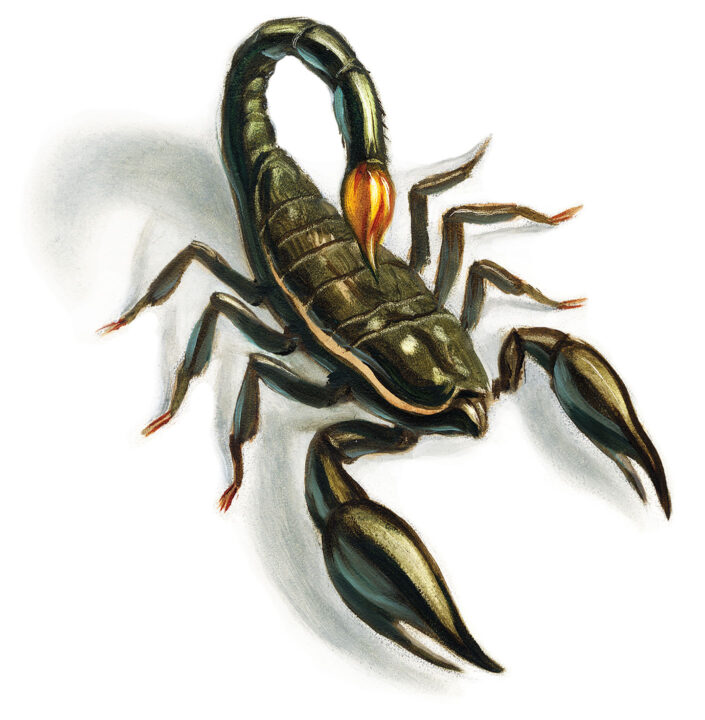
The authors held this up as proof that octopuses are observational learners. But other scientists were quick to cast doubt. “The study is kind of sloppy,” explained my dad, faulting the small sample size and the use of shocks. “People keep citing this paper over and over again, but nobody’s really gone back and done it again.” That intrigued Nichols, who brought it up with his classmate Mike Winter ’08, a neuroscience major, when the two were, of all things, snorkeling in a lake near campus. “Carey was talking to me about social learning in octopuses. I don’t even know where [he] got the knowledge from,” said Winter. “That’s really what spawned the project.”
At the time, there were a total of zero octopuses on campus and likely about the same in the entire state of Vermont. So Nichols and Winter proposed an idea that, by their own admission, was radical: let’s build our own octopus lab. “The problem was that no one had ever done that before,” said Nichols. “There was no one in a landlocked place trying to do this.” As they asked around BiHall for advice, the responses were expectedly tepid and the list of potential obstacles expansive. How were they going to get octopuses? What would it take to raise them? Where were they even going to raise them?
“I didn’t think it was possible at all,” said my dad, recalling his reaction to the proposal. “But they kept pushing, and rightly so. At some point I said, ‘Sure, let’s give it a try.’” Nichols and Winter scoured BiHall, literally knocking on doors in search of an empty room—any empty room—to set up in. That’s how they found MBH 367. “That room was so small and cramped,” said Nichols. “It was rough in there.” But it would do. And, with my dad’s help, they even talked the College into giving them a grant of a few thousand dollars to build the lab from the ground up.
They still wonder why Middlebury agreed to the lark. Nonetheless, work began in the spring of 2007, with the goal of having the lab ready by September, before it would be too cold to ship the octopuses. But what had seemed like ample time quickly became a crunch. “Everything was troubleshooting,” said Winter. “It was like putting together a car.”
There were tanks, filters, pumps, tables, outlets, sand, coral, salinity, pH levels, and any number of other variables to sort through. But, fortunately, help came from unexpected places. An aquarist in Burlington, for instance, was instrumental in setting the duo on the right path by offering expertise on proper aquarium setup. And, in the machine shop of BiHall, they met Tony Desautels, who taught them how to weld PVC and properly seal their tanks, among other crucial skills. “It was just a logistical nightmare,” said Nichols. “It failed a couple times.”
More than once they would fill their set of two 125-gallon tanks at night, only to return the next morning to find that all the water had slowly seeped out onto the floor. They would also test the water and find it too saline, turbid, or otherwise unsuitable for octopuses. “You’re basically trying to create the ocean in a box,” said Nichols, “which is exceedingly hard to do.”
Nichols’s favorite fail was when they had to purchase sand for their budding ecosystem. The advice they got was to buy specialized aquarium sand, which is quite expensive. In an effort to save money, they found a pick-up truck, drove to the Home Depot in Burlington, and bought playground sand. They lugged some two hundred pounds of the stuff back to Middlebury and poured it in their tanks. “It just made a huge, muddy mess,” Nichols told me. Days later, it still wouldn’t settle. “I remember your dad walked in and the tanks were just full of brown water.”
After they spent hours scooping the sand back out and trying to resolve a litany of other mishaps, the summer soon came to a close. It was time for the octopuses to arrive.
The first octopus shipped from Texas just in time to beat the cold. The hope, Nichols said, was to keep it alive long enough to design a social learning experiment. What became immediately clear, however, was that the octopuses were going to dictate their own futures.
Nichols and Winter thought they were getting a male octopus. But, it turns out, it’s not very easy to determine the gender of an octopus. The only difference is that the male has a thin tube running down its third arm, which it uses to pass sperm and inseminate females. So it came as a surprise when, almost immediately after being put in its tank at Middlebury, the “male” octopus laid eggs. Nichols and his then girlfriend (now wife) spent three hours fighting the new mother for the eggs so they could send them back to Texas to be raised.
Eventually, Nichols got more octopuses from Texas, and enough survived that they could finally start in on the science they had initially set out to undertake. Like the earlier social learning experiment, their setup was pretty simple. They built a round maze, with an outer circle and a smaller inner circle, like a dartboard. They would put an octopus in the middle of the maze. To one side there was an X, and to the other was an O. The researchers would then shine a light on the octopus, which would try to avoid it. Behind the X was a dark shelter it could escape to. Behind the O was more light.
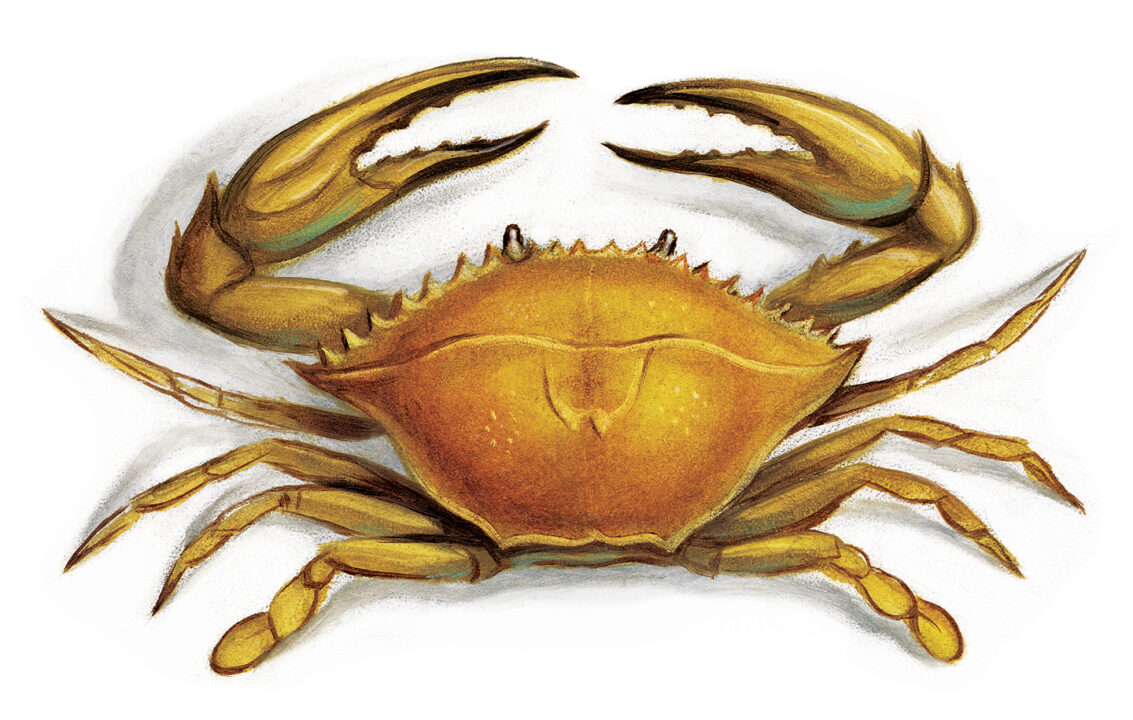
Half the battle was wrangling the octopuses between trials. The notorious escape artists can squish themselves through holes as small as a quarter, and Nichols says they routinely got out of the maze. One ended up back in its tank, leaving Nichols baffled as to its whereabouts. “They’ll outfox you whenever they can,” he said. “They’re like really smart Jell-O.”
Slowly, though, the experiment began working. “We got the initial individual so that it could do it pretty reliably within a few seconds,” explained Nichols. They could turn the maze or alter its location, and the octopus would still go toward the X. All the while, another octopus could watch and would then try to imitate the first one.
Nichols and Winter recall a general trend toward the second octopus being able to more quickly pick up the task—though their data didn’t end up being statistically relevant or conclusive. But neither of them saw these scientific results as the ultimate benchmark of success. To them, it was more about the experience; the journey. “That process of being a little bit creative and thinking outside of the box is a life skill,” said Winter, who is now a doctor. Nichols, who is also in medicine as an emergency room physician, agreed. “I can’t tell you how many weird things come in my front door that you have to figure out, and that’s like trying to keep an octopus alive.”
When Nichols and Winter graduated in 2008, neither they nor my dad had much of a plan for what would happen to the octopus lab. “We hoped at the least that we cleared the way for the next years of students to dedicate a little less mental energy to tinkering,” said Nichols. Other than that, though, it was up to a new cohort of students and octopuses to take over. The task fell, in large part, to Alexa Warburton ’09.5.Warburton remembers encountering some of the same obstacles as her predecessors. The pump would break—and Tony Desautels (who has since left the College) would help her fix it. Then there was the time that the power went out and the lab, because it was a former storage closet, wasn’t connected to the backup generator. She had to run extension cords across the hall to save the octopuses. But there was also, as Nichols had hoped, more room for scientific pursuits.
Warburton, my dad explained, decided to take a step back. Instead of jumping straight into complex intelligence studies, she aimed to answer more basic questions. Specifically, she asked, what senses do octopuses rely on most to suss out their surroundings? Perhaps sight, or maybe touch? To find out, Warburton built another maze, this time in the shape of a T. The octopuses would come to the end of the maze to find that at one end of the T was one type of stimulus (smell, visual cue, spatial element, etc.) and at the opposite end, another type. The animal would make a choice and Warburton would analyze the data for trends or preferences. “Really, the octopuses were too smart for it,” she said. “They are brilliant. . . . They are smarter than the cats that I have right now.” Nonetheless, her research made clear that octopuses primarily use their eyes (sight) and arms (touch) to get around.
My dad called her work “especially impressive.” Warburton was even featured prominently in the best-selling book Soul of an Octopus by Sy Montgomery. My dad adds that Warburton’s work also helped inform subsequent research by future students. “Prior to her work, we were trying to do learning studies without much success,” he said. “After her, we actually had quite good success because we learned from what she did.”
Arguably, the lab’s most noteworthy achievement of late, though, was spearheaded not by a student, or my dad, but by a woman named Alexis Paquette.
Paquette started working at Middlebury in 2015, on the animal care staff in BiHall (a team she later led). The octopuses, she said, were among the most finicky animals she had to look after. “Partial water changes twice a week. We’re looking at the pH, nitrate and ammonia levels . . .” She trailed off. “It’s not like rat cages.”
One major challenge was keeping the octopuses in their cages. The team resorted to putting bricks on the lids, which mostly worked. What they were less successful at was keeping the individuals separate—the animals always seemed to find ways, and crevices, via which to sneakily interact. For male and female octopuses, this meant mating, eggs, and eventually a gaggle of tiny, translucent babies. While adorable, newborn octopuses are extraordinarily fragile and extremely difficult to feed. They’re also cannibalistic, meaning that if they get too hungry, they start eating one another.
Although dozens of babies would hatch, none would survive more than a few weeks. Paquette wanted to change that, so she dug into the literature. One of the primary issues she found was that the youngsters needed a more tailored food source. After much searching, she found a hobbyist in Oregon who told her that he raised octopus babies in his garage by feeding them small snail larvae that he collected along his local coastline. She had him ship some to Vermont. As she learned more, Paquette also thought that instead of housing the youngsters separately, she’d try putting them all into one tank for an easier, more natural, feeding experience. “Let’s group them together, give them tons of food resources, and then they can feed,” she said. “That’s what we did, and it worked.”
In 2016, Middlebury became one of the few labs in the country to have “closed the lifecycle” on octopuses—a term referring to the ability to raise multiple generations in captivity. “What we’re doing is groundbreaking,” said Paquette, at the time. “No one else is doing this right now.”
On the lab’s 11th anniversary, Cece Wheeler inherited some octopuses that had been born at Middlebury (such as Goose) and others that had been brought in to augment the gene pool.
Her work on camouflage, my dad said, was original, and may result in one of the lab’s first published papers (though that’s still to be seen). In any case, he said, “I think it’s very important. It’s a nice way to be ending this research.”
Goose died on February 7. Throughout the month, the rest of Middlebury’s octopuses also passed away—which was expected, given the animals’ one- to two-year life span. It had happened plenty of times before. But, for the first time in more than a decade, Middlebury won’t be raising more. “It’s sad,” said my dad. “This lab has given dozens of students the opportunity to do research projects with a highly intelligent animal that’s very different from anything else they’re likely to experience in their lives.”
For him, too, it’s been a profound experience. His transformation is perhaps best seen when he finds octopus on a restaurant menu, or in a store. A decade ago, he would occasionally give it a try. I remember when I was a kid, he even ordered some for an invertebrate class lunch; the leftovers from which ended up on our dinner table at home. Today, though, he won’t touch octopus. “They’re too smart,” he says of the animals that have, for years, lived just across the hall from his office.
The punny (and grammatically incorrect) “Octopi Wall Street” cartoon on the door of MBH 367 came down this spring. The tanks and other apparatuses remain while the department figures out what to do with the space (the leading option is to use it for coral research). My dad sees this reset as a blank slate, a canvas—an opportunity for Middlebury to yet again try something new and different.
With a handful of other biology retirements in recent years, the department is on the hunt for its next cadre of scientists. “[They] will change the way we teach biology and do research in biology for a generation or two or three to come,” said my father. “When I first came here that’s what I was told, and I did my time and made biology go in some directions that I think I’m very proud of. And now it’s other people’s turns.”
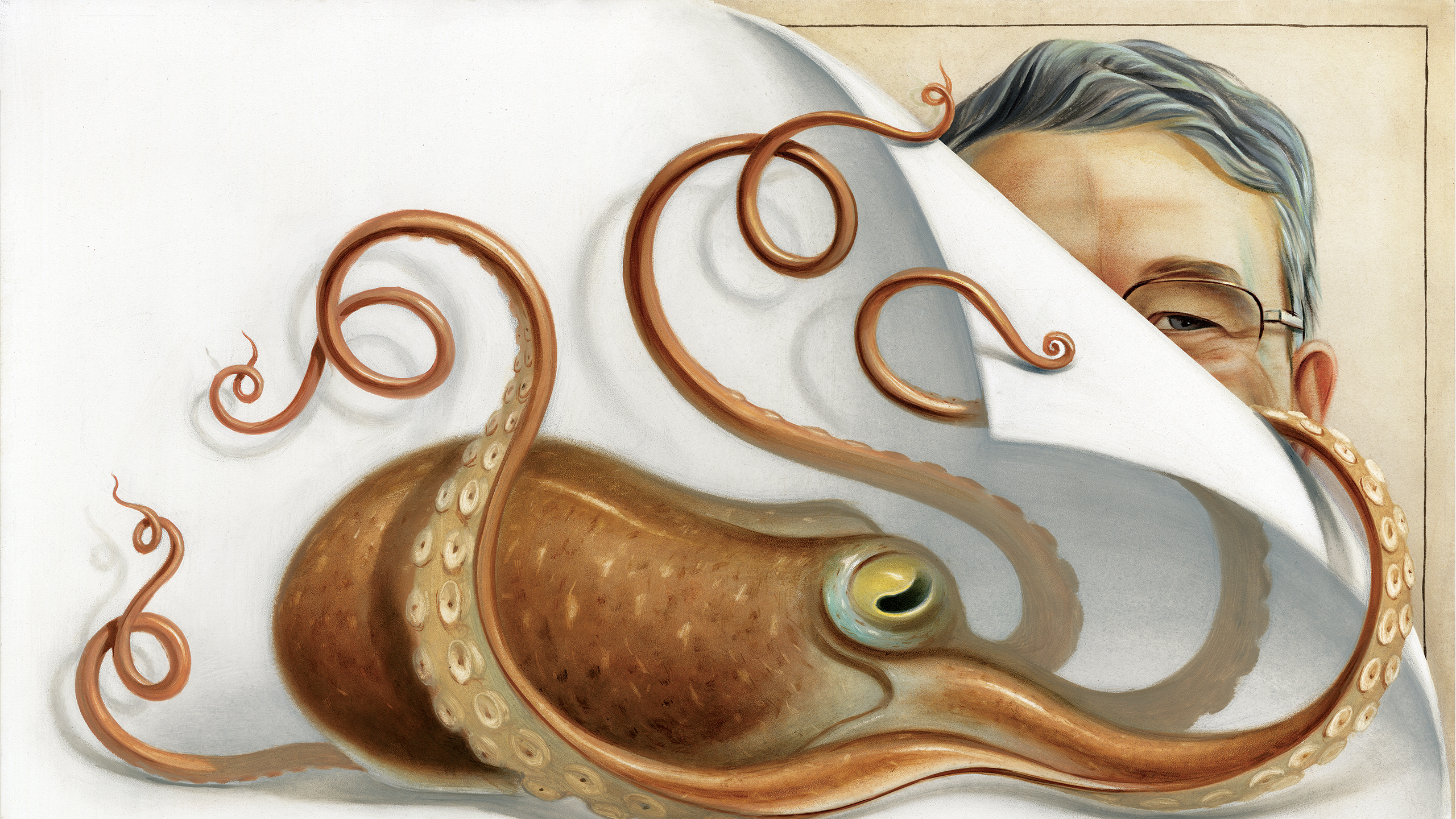
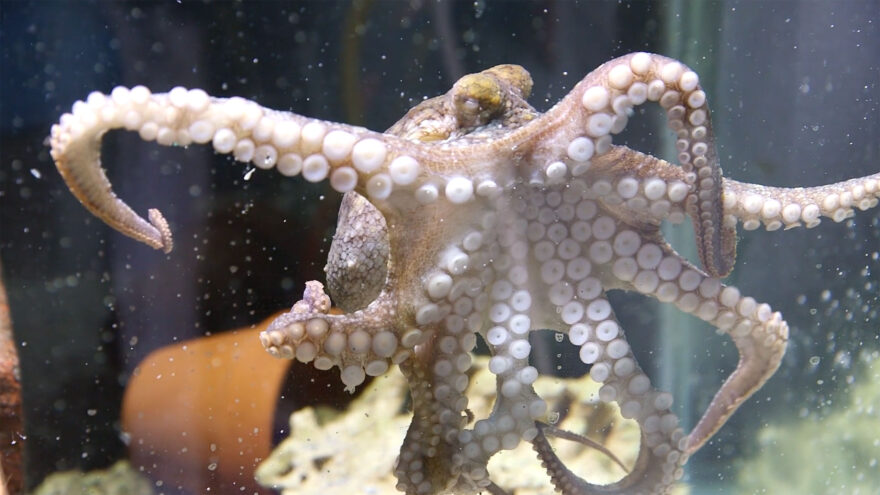
Leave a Reply